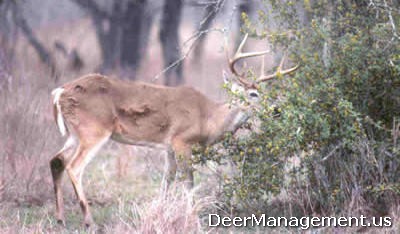There are many theories when it comes to producing good white-tailed deer year after year, but the common theme among all deer management techniques is to provide good habitat. Habitat plays a critical role in a deer’s life because this is where they find their food. Good nutrition is required for individual deer to be healthy, and a bunch of healthy bucks and does make for a healthy herd. Habitat is the cornerstone of deer management.
Like many states, habitat is in poor condition across much of Texas this year. One of the hardest hit regions is the Texas Hill Country, located in the center of the state. This region has boasted the highest deer densities and hunter numbers for at least the past three decades, and although hunters should not expect a big change this fall, whitetail bucks, does and fawns are having a tough go of it this year.

Mike Krueger, the Edwards Plateau district leader for Texas Parks and Wildlife Department, also said it’s tough to predict how things will shake out, but based solely on moisture levels, the general forecast doesn’t look as good as it previously has. He stated, “There’s very few places in the state of Texas that weren’t under drought conditions from this past fall into the summer. Most food plots were complete flops. Much of the western side of the Edwards Plateau was under what’s termed exceptional drought. It looks maybe a little bit better over on the eastern side of the district because they got some of those heavier rains when tropical storms came through.”
Heading into the summer there should be a lot of herbaceous plants and a lot of cool-season forbs finishing up growth, but drought conditions have kept vegetation at bay. Warm-season forbs should be in good production, but landowners are not seeing those plants either. Deer are utilizing a lot of woody browse plants, which is fine because they are nutritious as well. The concern is that the deer eating those browse plants now will not have that forage available to them later in the summer when the herbaceous plants are gone. In short, deer are essentially dipping into their savings account by eating their summer foods right earlier than normal.
Looking ahead, Krueger said the effects of below-average range conditions only get exacerbated as it gets hotter. “There may not be a whole lot left when we get into July and August when it truly is hot,” he said. “The prognosis for deer reproduction is not good because there’s not a lot of cover out there and just not a lot of vegetation that can provide cover for fawns. There’s also not likely to be a lot of milk-producing forbs for mama deer so it just doesn’t look good for reproduction of deer and other non-game species.”
Last years fawn are not out of the woods yet either. They are still developing bone and growing muscle and they’re under poor, stressful conditions. With this in mind, it is conceivable that Central Texas landowners could lose two back-to-back fawn crops. Last year’s fawn crops could still see some mortality, and this year’s crop could be very low just because of bad habitat conditions. If conditions remain dry hunters may see a good number of deer at their feeders, but it may hurt deer hunting and deer management efforts in future years. Time will tell.